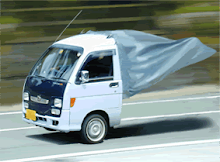 Tun Mahathir yang mengilhamkan Putrajaya dan Siberjaya hari ini berang dan ternyata kecewa dengan perkembangan pembangunan Siberjaya yang amat lembap dan lambat.
Tun Mahathir yang mengilhamkan Putrajaya dan Siberjaya hari ini berang dan ternyata kecewa dengan perkembangan pembangunan Siberjaya yang amat lembap dan lambat.Siberjaya dibangunkan sejak 12 tahun lalu menggunakan wang cukai rakyat dan mendapat tentangan dari pelbagai pihak termasuklah puluhan badan bukan kerajaan (NGO).
Segelintir penganalisis politik berpendapat, Idea pembangunan di Putrajaya dan Siberjaya memang baik, tetapi perlaksanaannya tidak melihat kepada keutamaan pembangunan negara.
Lagipun pembangunan itu hanya dinikmati oleh seolongan rakyat selain pembinaannya ditaja oleh negeri2 miskin di malaysia.
Sabah misalnya yang suatu ketika dulu berada di belakang Selangor sebagai negeri kedua terkaya di Malaysia, turut diragut kekayaannya menerusi hasil kepada kerajaan pusat.
Lebih malang lagi, kebanyakan dana yang digunakan menerusi hasil kekayaan minyak negara di tiga negeri utama di Malaysia termasuk Sabah, Sarawak dan Terengganu.
Ketiga2 negeri tersebut juga adalah negeri yang diperintah oleh BN sejak berpuluh tahun.
Kesannya, di tiga negeri inilah yang sejak puluhan tahun lalu tersungkur di kedudukan lima terbawah dalam senarai negeri termiskin di Malaysia.
CYBERJAYA: Former Prime Minister, Tun Dr Mahathir Mohamad today (14 May) expressed dissatisfaction with the progress made by Cyberjaya since its development began 12 years ago.
"It has seen tremendous progress. You can see buildings, houses and IT-related business here. The university is expanding and MSC is much more active now.
"But if you ask me, am I satisfied? The answer is no. I like things faster.
More faster, better and sometimes more expensive," Dr Mahathir said.
He said the earlier plan for the creation of a community of foreigners working and living here has not happened. (aiseh man... diut rakyat tempat bina siberjaya, tapi untuk manfaat warga asing????-bangang ounya Tun)
"When we planned Cyberjaya, we expected a lot of foreigners to live here in a special environment created for them. An environment that is very attractive where they can interact with each other," he said.
There was supposed to be a community that would focus on IT and communication and stay here but what is happening is a lot of people prefer to stay elsewhere and work here, he said.
Asked on what was needed to achieve that, Dr Mahathir said the government could consider giving Permanent Resident status to skilled and qualified foreigners besides creating a condusive environment for them.
"If we catered more for the people who want to come, I think they will come. I think there must also be a quality of life here as that is important. They should also have a good environment to work in," he said.
Having good infrastructure will also attract them to come here. It includes having clubs, places for relaxation, sports areas, and more houses.
"You can see here too many cars. They all come in their cars. I would prefer they live here, ... attend club, play tennis and walk to office. That was what that was planned but it has not happened."
Dr Mahathir said this at the Cyberjaya Malaysia-Bridging Business Needs Globally, Asia Pacific Outsourcing Services Post Event Tour, here today.
He delivered a special talk on "Malaysia-Today's Knowledge Economy." The tour was organised by Setia Haruman Sdn Bhd, the master developer of Cyberjaya. Cyberjaya is the brainchild of Dr Mahathir. (Bernama)
Pesanan: kepada pengundi tok tok Bee End, masih kah mahu mengundi BN?
Gambar yang tertera adalah salah sebuah kereta yang terbabit dalam kemalangan di Siberjaya beberapa tahun lalu.





1 comment:
Mungkin anda kurang membaca perihal sejarah strategi pembangunan sesuatu projek 'out of the box'.
Pengumpulan pakar-pakar (terutamanya pekerja knowledge based) untuk ditempatkan di dalam suatu kawasan sememangnya suatu kelebihan untuk memajukan suatu projek baru .
Contoh peneroka awal ialah Silicon Valley di Amerika,
Kemudiannya seluruh dunia sedar dan masing2 secepat mungkin membina bandar IT masing2 seperti di berikut ;
Hong Kong Science Park - New Territories
India
Bangalore (The Silicon Valley of India), ITPB
HITEC City - Hyderabad
Tidel Park - Chennai
Kolkata - West Bengal
The Knowledge Corridor - between Pune and Mumbai
Pune
Technopark, Trivandrum - Thiruvananthapuram, Kerala
Gurgaon, Haryana - near Delhi
Noida, Uttar Pradesh - near Delhi
IT Park - Chandigarh
Iran
Pardis (The Pardis Technology Park),[6] (Iran's Silicon Valley)
Israel
Tel Aviv/Mediterranean Coastal Region - referred to as Silicon Wadi
Japan
Kansai Science City, on the borders of Kyoto, Osaka and Nara Prefectures
Tsukuba Science City, Tsukuba City, Ibaraki Prefecture
Yokosuka Research Park (YRP), Yokosuka City, Kanagawa Prefecture
Malaysia
Multimedia Super Corridor / Cyberjaya - Kuala Lumpur
Pakistan
Arfa Karim Technology Park (former Software Technology Park) - Lahore[7]
IT Media City - Karachi
Philippines
Silicon Gulf - Davao City (The Silicon Valley of the Philippines)
Singapore
Singapore Science Park[8] The southwestern corner of Singapore
South Korea
Digital Media City, Seoul
Samsung Town, Seoul
Teheran Valley, Seoul
Songdo Science Village, Songdo International City, Incheon
Daedeok Science Town, Daejeon
Taiwan
Hsinchu Science Park, Hsinchu City & Hsinchu County
Southern Taiwan Science Park, Tainan City & Kaohsiung City[9]
Nankang Software Park, Taipei City[10]
Neihu Science Park, Taipei City
Central Taiwan Science Park, Taichung City & Yunlin County[11]
Turkey
Ankara Cyberpark - Ankara[12]
Metu Technopolis - Ankara[13]
Thailand
Thailand Science Park, north of Bangkok
Software Park Thailand, Bangkok
UAE
Dubai Internet City, Dubai
Dubai Silicon Oasis, Dubai
Dubai Media City, Dubai.
Tenaga2 pakar ini akan bergabung dengan tenaga pekerja tempatan yang mana akhirnya terus-terusan membawa perubahan ekonomi berdasarkan pengethuan yang menjadi kunci ekonomi masa depan.
Setiap mereka berlumba2 memberi inisatif kepada para pekerja istmewa ini sebagai pemangkin kepad kemajuan negara.
Malang sekali orang seperti anda melihat dari sudut sempit sahaja.
Anda harus banyak membaca lagi...
Post a Comment